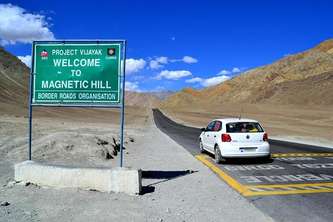Visit The Karpaka Vinayakar Temple For A Historic And Spiritual Experience In 2025

Do you ever feel like visiting a temple and being taken into a world of religious bliss? If not, the mighty Karpaka Vinayakar Temple will surely give you a chance. The devotion weaves spiritual patterns here, and all problems are forgotten in the serene halls of this ancient temple. Located in the Southern Indian state of Tamil Nadu, the Karpaka Vinayakar Temple offers a testament to faith and an architectural marvel. Here, the deities are not in an instant but stay with you through the intricate carvings. Learn about this and more in the content that follows:
Karpaka Vinayakar Temple- Symphony In Stone Overview
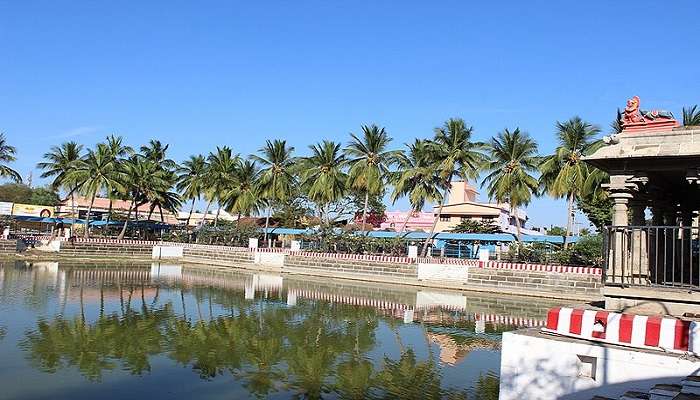
Karpaka Vinayakar Temple is a brilliant 7th-century rock-cut cave temple, also called the Pillayarpatti Pillayar Temple. The complex has undergone substantial expansions across various centuries. The temple is in Tamil Nadu, India, Sivaganga district, Pillayarpatti village, Tirupattur Taluk. The temple honours Karpaka Vinayakar, often known as Ganesha.
Inside the cave temple, images of Ganesha and Shiva linga, as well as other carvings that have been identified as Ardhanarishwara, Harihara, or the early monarch who constructed this temple, can be found. These are all noteworthy due to their distinctive iconography. Panchaloha statues, which belong to the eleventh century, were found in the late 1800s during restorative excavation and repair work.
Also Read: Best Tourist Places In Tamil Nadu
Historical Importance Of Karpaka Vinayakar Temple

Interestingly, eleventh- and thirteenth-century stone inscriptions can be found on the temple’s walls and mandapams. The temple is also one of the nine ancient Hindu temples belonging to the Chettiar family. The temple’s significance was inscribed in the Chettiar family’s customs in the Kali year 3815 (714 CE). The temple features a massive, vibrant gopuram, artistically painted mandapams, numerous shrines within, salas that were initially created for dancing and singing hymns, a kitchen, architecture that is based on the Shilpa Sastras and Agamic scriptures, and a sizable temple tank to the north.
Most of these were added to the main rock-cut cave sanctuary in later years. The temple is open daily and draws many visitors, mostly women, especially during the annual chariot processions and festivals like Vinayaka Chaturthi and the Brahmotsavam in the Tamil month of Vaikasi. According to Chettiars’ tradition, their community has worshipped in this Shaivism-style temple from the Kali year 3813 (corresponding to 714 CE). Through sub-communities centred on Shiva temples, such as the Pillayarpatti and Elayatrankudi Pirivu, Chettiars have arranged their conservation and temple-building projects. Given its historical significance with the Shiva linga and the Karpaga Vinayaka, this temple is regarded as belonging to the Shiva tradition. This may also be why many tourists from northern India are interested in visiting this temple.
The Main Sanctum Of Karpaka Vinayakar Temple
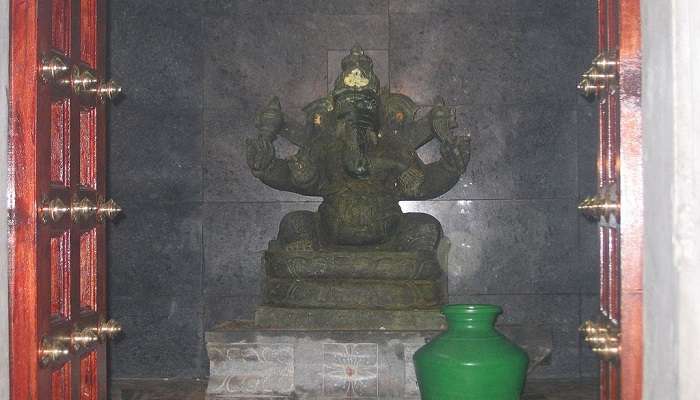
The main sanctum, the Vinayagar Sannidhi (sanctum sanctorum), is devoted to Lord Ganesha. A 6-foot-tall bas-relief of Karpaga Vinayagar has been chiselled out of the rock on its southern face. This Ganesha deity is facing northward. Since this cave was dug out of a sizable rocky outcrop in nature, pradakshina, or circumambulatory passage, is not provided for. Ganesha’s imagery is unique in a few aspects. He only has two hands to start. Second, in contrast to later statues that usually depict him with four hands, his trunk is turned to the left, and sweets in one of his left hands; he holds sweets in his right hand, and his trunk is curled at the right side.
Ganesha’s left tusk is fractured in the Karpaka Vinayakar Temple, indicating that some of the god’s iconographic elements were already well-established when this picture was carved. This legend is known locally as Valampuri Vinayagar. Besides the Ganesha Diet, an inscription from the 7th century calls the story “Desi vinayagar”.
Related Post: Tiger Hill Cemetery
The Shiva Sanctum

On the west face of the cave wall, a Shiva shrine with an eastward entry is located inside a vanaprastha, or elephant-back kind of excavation. At its core is a Shiva linga from the seventh century. The words “Ikkatturu Kotturu Ainiijan” are prominently engraved inside this sanctum. These are probably the name(s) of the patron(s) who oversaw its excavation.
The inscription’s palaeographic quality makes it noteworthy. With some Tamil Brahmi influence, the script is more ancient than the oldest Vatteluttu, but it is unmistakably not Tamil Brahmi. Its features date later than the Tamil Brahmi of the third century CE. Another remarkable bas-relief for tourists depicts a standing royal human form with two attendants. This is located between the Shiva shrine and the rock-cut Ganesha. Different interpretations have given this as either a king between two officials or Ardhanarishwara, who is half Shiva and half Parvati, or Harihara, who is half Shiva and half Vishnu.
Festivals Celebrated

The temple is an essential hub for the yearly Vinayaka Chaturthi celebration, which is observed for ten days. Locals in the area get together for the chariot festival on the ninth day, when they participate in a religious fest parade through the streets. The processional Ganesha statue, accompanied by his parents Nataraja and Sivakami, is carried in a mouse vahana and coated with gold plating.
During these days, the temple hosts performances, exhibitions, floor decorations, and sandal coverings (Chandana Kaappu). Since festival idols made of panchaloha were discovered during temple restorations and renovations in the late 19th century, this ritual has gained more significance. They probably date back to the eleventh century. Tamil women love celebrating Vinayaka Chaturthi, also known as Ganesha Chaturthi.
Related Post: Places To Visit In Kanchipuram
Later modifications
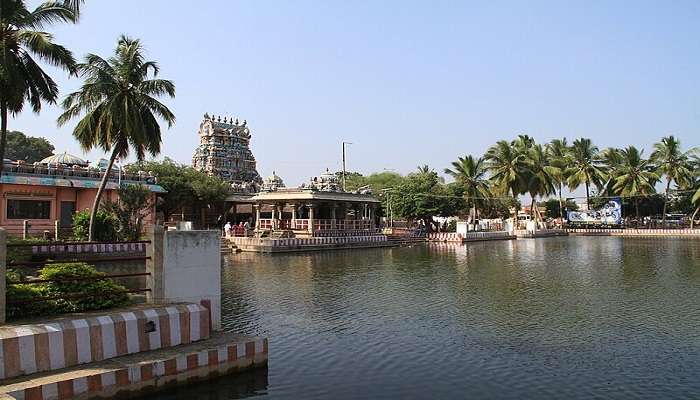
Subsequent additions were made to the temple, including a Shiva shrine, a Nataraja shrine, a Chandesar shrine, a Sivakami Amman temple, and various mandapams (Maha, Thirumurai, Alankara). A panel depicting the Saptamatrikas, also known as Saptha Kannimar, or the seven mothers or seven virgins, is located parallel to and close to the excavated cave on the southern side of the mandapam.
The temple also has shrines or areas dedicated to Bhairava (Shiva form) and his dog, Somaskanda, Kartikeya and his two wives, Valli (who arranges marriages), Devasena, also known as Deivayanai (who gifts offspring), Pasupatheeswarar, (who showers all wealth), Navagrahas, and two gopurams (on the east and north sides). Karpaka Vinayakar has a big temple kitchen called madapalli and a temple well inside the mandapam to offer pilgrims water for charity, similar to prominent Shaiva-style temples. The temple also features areas for performing arts and hymns sung in devotion.
Getting There
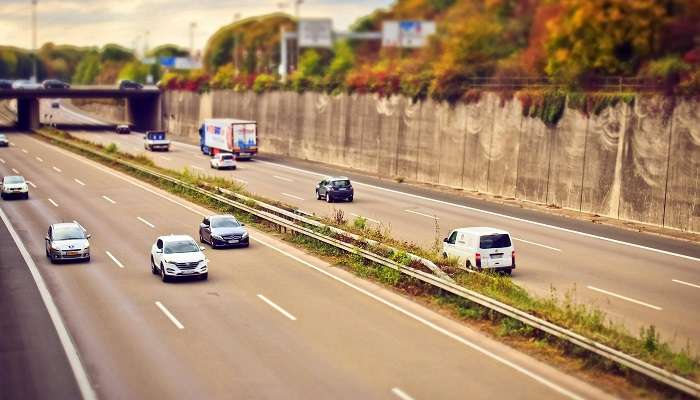
The Karpaka Vinayakar Temple sits on the eastern edge of a rocky hill in the settlement of Pillayarpatti (sometimes written Pillayarpatti). The temple is located in Tamil Nadu, roughly 15. km (9.3 mi) northwest of Karaikudi town and 75 km (47 mi) northeast of Madurai city. The town of Tirupattur is located around 12 kilometres to the east of Pilliyarpatti. State Highway 35 and National Highway 36 both lead to Pillayarpatti.
In this village’s Pillayarpatti Hillocks, a cave contains a carving of Karpaga Vinayagar. Along with numerous 7th-century bas-reliefs, this cave contains carvings of Thiruveesar or Shiva. All buses are well-connected to the temple. Karaikudi is the nearest railway station.
You May Also Like To Read: Hotels In Urapakkam
It is quite easy to be taken aback by the well-preserved beauty of the Karpaka Vinayakar Temple. For those who may find it difficult to connect to the spiritual essence of the complex, there will be chances here to connect to your inner soul. Plan your trip to Tamil Nadu, and make sure you add a visit to this temple to garner some travel-worthy memories.
For our editorial codes of conduct and copyright disclaimer, please click here.
Cover Image Credit: Ms Sarah Welch for Wikipedia
Frequently Asked Questions About Karpaka Vinayakar Temple
How old is the Karpaka Vinayakar Temple?
The Karpaka Vinayakar Temple is an ancient temple that was built in the 7th century CE.
What are the entry fees to Karpaka Vinayakar Temple?
Entry to the temple is free. Although, devotees can donate as per their choice for the betterment of the temple.
What is the dress code for the temple?
While there is no strict dress code, it is advised to dress modestly, covering knees and shoulders.
Who is the main deity in the Karpaka Vinayakar Temple?
The main deity of Lord Ganesha, the Hindu God of Wisdom is established at the main sanctum of the temple, besides the Shiva sanctum.
What is the meaning of Karpaka Vinayakar?
It translates to the god of wisdom, Lord Ganesha. Explore the temple and get into the spirituality and blessings of lord Ganesha.
People Also Read:
Budhanilkantha Temple Shrungagiri Shanmukha Temple Chintaman Ganesh Temple

Unveil the hidden treasures of the globe and turn every travel dream into reality. As a Content Writer, I am passionate enough to craft stories from ancient wonders to modern marvels. My words paint the picture-perfect itinerary for unforgettable experiences. Let my words be your trusted guide to immerse in the diverse culture and discover the beauty of the unknown.






